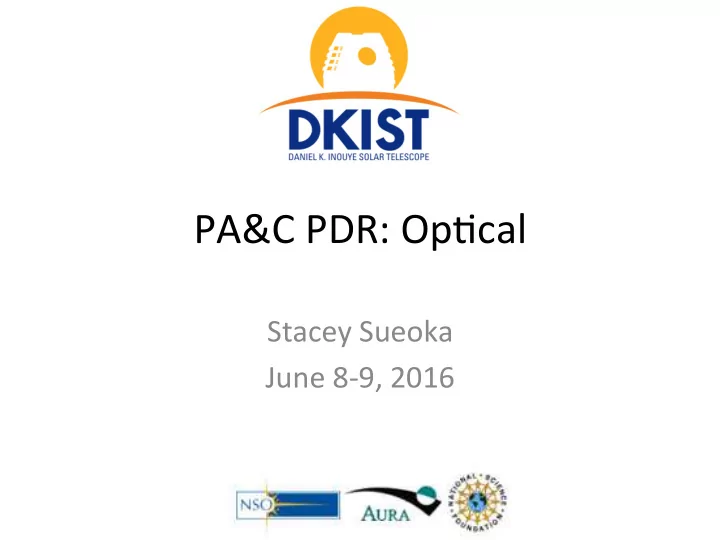

PA&C PDR: Op+cal Stacey Sueoka June 8-9, 2016 1
Mee+ng GOS DRD Op+cal Requirements for the calibra+on linear polarizer and retarder • Calibra+on Op+cal Element: • Calibra+on Retarder: – 3.1.5 Wavelength range – 3.1.20 Aperture – 3.1.6 Beam Deflec+on – 3.1.21 Reflec+vity & transmission – 3.1.7 Coa+ng absorp+on – 3.1.22 Retarder plate thickness – 3.1.8 Op+cal polish – 3.1.23 Linear retardance & clocking – 3.1.13 Wavefront error – 3.1.26 Retarda+on – 3.1.14 Opera+ng temperatures – 3.1.27 Thermal stability • Calibra+on Linear Polarizer: – 3.1.15 Aperture – 3.1.16 Reflec+vity &transmission – 3.1.17 Thermal stability – 3.1.19 Ex+nc+on ra+o
SAR/PCM design history and fabrica+on update • Contract in place with Meadowlark Op+cs Inc. to build the 3 calibra+on retarders and 3 modulators
March 2015 Acceptance Tes+ng • AR coa+ng absorp+on • Clocking error
NSO Laboratory Spectro-Polarimeter Setup: Polariza+on components 8 7 6 10 9 6) Calibra+on polarizer 7) Calibra+on retarder 8) Sample 9) Modulator 10) Analyzer polarizer 5 5
Mueller Matrix measurements and fit • Fit for the fast axis orienta+on of each pair !" ! ! !"#$ , ! ! . !" ! ! !"#$ , ! ! . !" ! ! !"#$ , ! ! • It was determined that and were the correct clocking ! ! ! ! angles, but was rotated by . ! ! 90 ° Mueller matrix measurements from 400 to 2000nm Blue points are measured results Red curve is the design Red curve is the fit
Meadowlark progress update and +meline Polishing: Completed for all plates Clocking/chording: Test in prototype • • except the last few MgF2 plates for mount before final assembly Cryo-NIRSP July/Aug.: DKIST team tests clocking • AR coa/ng: Strip and recoat • Sept.: Receive final assemblies, • perform acceptance tests
Calibra+on retarder thermal • Opera+onal thermal stability – Used thermal FEM to derive usable dura+on due to thermal effects
Bulk and gradient temperature effects
DL-NIRSP and ViSP Calibra+on Retarders • Bulk temperature rise of 4C • Thermal gradient – Polarizer in – Established >80% of steady-state amplitude in < 4 minutes • Worse coa+ng absorp+on, > 20 min – Polarizer in, both coa+ng cases, • Befer coa+ng absorp+on, ~0.2C gradient > 40 min – Polarizer out, both coa+ng cases, – Polarizer out ~0.75C gradient • Worse coa+ng absorp+on, > 5 min • Befer coa+ng absorp+on, > 7 min Cryo-NIRSP Calibra+on Retarder • Bulk temperature rise with polarizer in is negligible, out is ~2C • Thermal gradient TBD pending analysis of recent thermal FEM
Calibra+on Linear Polarizer • Moxtek wire grid polarizer – 1mm substrate • Infrasil – UVT240A overcoat to protect from oxida+on » Working with Moxtek, trying conformal aluminum oxide overcoat which DOES NOT degrade the contrast ra+o • Sapphire ROM Quote $8.5K – Great for Cryo-NIRSP, but not a heat stop for quartz like infrasil
Calibra+on polarizer thermal • Survival temperature: >>200C • Opera+onal temperature 200C • Expected temperature ~70C – Aluminum wires absorb – Infrasil absorbs IR
Ar+ficial Light Source Design • Previous study performed to select the source: – Super con+nuum laser vs arc lamp source • Conclusion: Arc lamp is the chosen source – Study men+ons as one of several reasons to choose the arc lamp is “the beam diverges from the LASER at a F/# that varies as a func+on of wavelength. ” Mee+ng GOS DRD Op+cal requirements for the Ar+ficial Light Source – 3.1.28 Ar+ficial broadband light source • 3.1.28.1 Power • 3.1.28.2 Uniformity – 3.1.28.3 Stability
Light feed design in Zemax
Recommend
More recommend